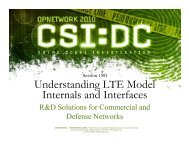Automated Axon Tracking of 3D Confocal Laser Scanning ...
Automated Axon Tracking of 3D Confocal Laser Scanning ...
Automated Axon Tracking of 3D Confocal Laser Scanning ...
You also want an ePaper? Increase the reach of your titles
YUMPU automatically turns print PDFs into web optimized ePapers that Google loves.
similarity can be assumed between consecutive cross-sections. The various parameters involvedin the algorithm are discussed here.Deciding the training set 'N'Selecting the number <strong>of</strong> training samples used to estimate statistics <strong>of</strong> our features is animportant decision. A large number <strong>of</strong> samples will average out the variations in the crosssections,resulting in improper segmentation while fewer samples mean a larger variance, whichcauses increased likelihoods to lie in either <strong>of</strong> the two extremes. In our case, we have chosentraining samples from 10 previously segmented slices. We emphasize that this choice wasemployed quite successfully across the three different data sets analyzed in Section 3.Deciding the featuresThe features are extracted from previously segmented slices by fitting an ellipse to thesegmented axons. Popular features that are usually used for training a model such as this arelength <strong>of</strong> major axis, length <strong>of</strong> minor axis, perimeter, average intensity, difference in centersfrom one cross-section to the next, area and orientation (Li et al., 2007; Wang etal., 2007).Since the axon cross-sections have irregular shapes and varying intensity, only a few features canactually be useful in our case. It should be noted that even though the cross-sections haveirregular shapes, the change in their shape from one cross-sectional image to the next is notabrupt. The features have to be selected such that the likelihood increases only if the regiongrows into a particular shape and at a particular angle. We have found that orientation andperimeter are sufficient features to properly guide the algorithm to converge to the actual shape<strong>of</strong> the axon in the cross-section.Building the probabilistic feature modelAfter extracting the features from the previously segmented images, they are fit to Gaussian19















